ECO mode SKODA OCTAVIA TOUR 2010 1.G / (1U) Columbus Navigation System Manual
[x] Cancel search | Manufacturer: SKODA, Model Year: 2010, Model line: OCTAVIA TOUR, Model: SKODA OCTAVIA TOUR 2010 1.G / (1U)Pages: 207, PDF Size: 12.63 MB
Page 2 of 207

IntroductionYou have opted for a Škoda - our sincere thanks for your confidence in us.
Your new Škoda offers you a vehicle featuring the most modern engineering and a wide range of equipment which
you will undoubtedly wish to use to the full during your daily motoring. That is why, we recommend that you read
this Owner's Manual attentively to enable you to become familiar with your car and all that it offers as quickly as
possible.
Please do not hesitate to contact your specialist garage or importer should you have any further questions or any
problems regarding your vehicle which ma y arise. He will be ready at any time to receive your questions, sugges-
tions and criticisms.
National legal provisions, which deviate from the information contained in these operating instructions, take prec-
edence over the information contai ned in the operating instructions.
We wish you much pleasure with your Šk oda and pleasant motoring at all times.
Yo u r Škoda Auto
s2rc.book Page 1 Thursday, April 22, 2010 10:58 AM
Page 3 of 207

Introduction
2
On-board literature
The on-board literature for your vehicle consists of this “ Owner's Manual”
as well as the “ Quick Reference Guide ”, “Service Schedule” and “Help on
the road ”. There can also be a variety of other additional operating manuals
and instructions on-board (e.g. an operating manual for the radio)
depending on the vehicle model and equipment.
If one of the publications listed above is missing, please contact a specialist
garage immediately, where one will be glad to assist you in such matters.
One should note that the details give n in the vehicle's papers always
take precedence over those in the Owner's Manual.
Owner's Manual
This Owner's Manual describes the current scope of equipment. Certain
items of equipment listed are only inst alled later on and only envisaged for
particular markets. The illustrations can differ in minor details from your
vehicle; they are only intended for general information.
In addition to information regarding all the controls and equipment, the
Owner's Manual also contains important information regarding care and
operation for your safety and also to retain the value of your vehicle. To
provide you with valuable tips and ai ds. You will learn how you can operate
your vehicle safely, economically and in an environmentally conscious
way.
For safety reasons, please also pay attention to the information on
accessories, modifications and replacement of parts page 166.
The other chapters of the Owner's Manua l are also important, however, for
proper treatment of your car - in addi tion to regular care and maintenance
- helps to retain its value and in many cases is also one of the conditions for
possible warranty claims.
The Service schedule
contains:
Vehicle data;
Service intervals;
Overview of the service work;
Service proof;
Confirmation of mobility warranty;
important information on the warranty.
The confirmations of the carried out se rvice work are one of the conditions
for possible warranty claims.
Please always present the Service schedule when you take your car to a
specialist garage.
If the Service schedule is missing or worn, please contact the specialist
garage where your car is serviced regularly. You will receive a duplicate, in
which the previously carried ou t service work are confirmed.
Help on the road
contains the addresses and telephone numbers of Škoda Importers.
s2rc.book Page 2 Thursday, April 22, 2010 10:58 AM
Page 31 of 207
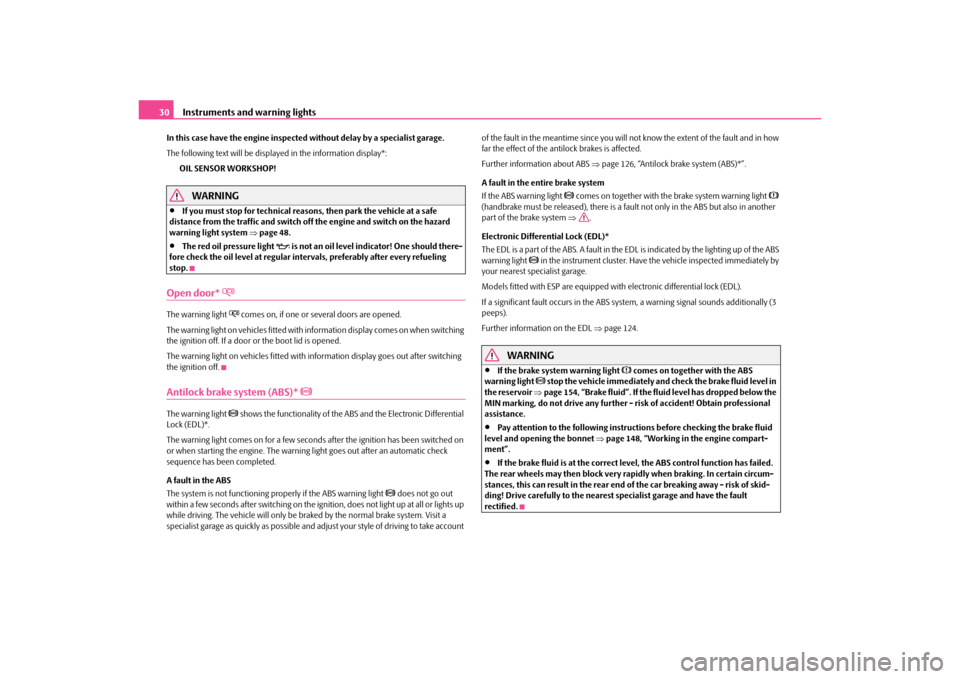
Instruments and warning lights
30
In this case have the engine inspected without delay by a specialist garage.
The following text will be displayed in the information display*:
OIL SENSOR WORKSHOP!
WARNING
If you must stop for technical reasons, then park the vehicle at a safe
distance from the traffic and switch off the engine and switch on the hazard
warning light system page 48.
The red oil pressure light
is not an oil level indicator! One should there-
fore check the oil level at regular inte rvals, preferably after every refueling
stop.
Open door*
The warning light
comes on, if one or several doors are opened.
The warning light on vehicles fitted with information display comes on when switching
the ignition off. If a door or the boot lid is opened.
The warning light on vehicles fitted with information display goes out after switching
the ignition off.
Antilock brake system (ABS)*
The warning light
shows the functionality of the ABS and the Electronic Differential
Lock (EDL)*.
The warning light comes on for a few seconds after the ignition has been switched on
or when starting the engine. The warning light goes out after an automatic check
sequence has been completed.
A fault in the ABS
The system is not functioning properly if the ABS warning light
does not go out
within a few seconds after switching on the ignition, does not light up at all or lights up
while driving. The vehicle will only be br aked by the normal brake system. Visit a
specialist garage as quickly as possible and adjust your style of driving to take account of the fault in the meantime since you will no
t know the extent of the fault and in how
far the effect of the antilock brakes is affected.
Further information about ABS page 126, “Antilock brake system (ABS)*”.
A fault in the entire brake system
If the ABS warning light
comes on together with the brake system warning light
(handbrake must be released), there is a fault not only in the ABS but also in another
part of the brake system .
Electronic Differential Lock (EDL)*
The EDL is a part of the ABS. A fault in the EDL is indicated by the lighting up of the ABS
warning light
in the instrument cluster. Have the vehicle inspected immediately by
your nearest specialist garage.
Models fitted with ESP are equipped with electronic differential lock (EDL).
If a significant fault occurs in the ABS syst em, a warning signal sounds additionally (3
peeps).
Further information on the EDL page 124.
WARNING
If the brake system warning light
comes on together with the ABS
warning light
stop the vehicle immediately an d check the brake fluid level in
the reservoir page 154, “Brake fluid”. If the fluid level has dropped below the
MIN marking, do not drive any further - risk of accident! Obtain professional
assistance.
Pay attention to the following instruct ions before checking the brake fluid
level and opening the bonnet page 148, “Working in the engine compart-
ment”.
If the brake fluid is at the correct leve l, the ABS control function has failed.
The rear wheels may then block very rapi dly when braking. In certain circum-
stances, this can result in the rear end of the car breaking away - risk of skid-
ding! Drive carefully to the nearest sp ecialist garage and have the fault
rectified.
s2rc.book Page 30 Thursd ay, April 22, 2010 10:58 AM
Page 37 of 207

Unlocking and locking
36
All the securing knobs move downwards when locking. If this is not the case, the rele-
vant door must be opened on ce again and properly closed.
The warning light flashes in the driver door, next to the securing knob, to confirm that
the vehicle has been correctly locked. The warning light will not flash if the safe
securing system is deactivated page 36.
This is not the case, however, for vehicles with an anti-theft alarm system* since the
indicator light is showing that the system is active.
Convenience operatio n of the windows
One can open and close the electrically powered windows when unlocking and
locking the vehicle page 43, “Window convenience operation”.
Opening a single door*
This function makes it possible to only unlock the driver's door. The other doors
remain locked and are only unlocked when the command is repeated.
If you wish, you can have a sp ecialist garage activate the function of the single door
opening mode.
WARNING
Locking the doors prevents involuntary opening in an exceptional situation (an
accident). Locked doors prevent unwanted entry into the vehicle from outside,
for example at road crossings. Locked doors do, however, make it more difficult
for rescuers to get into the vehicle in an emergency - danger to life!
Note
In the event of an accident in which the airbags are deployed, the locked doors are
automatically unlocked in order to enable rescuers to gain access to the vehicle.
Only the front doors can be unlocked and locked using the key if the central locking
system fails. You can lock or unlock ma nually the other doors and the boot lid.
Emergency locking of the door page 38.
After locking the vehicle via the central lo cking system, optically check if all the
doors have been locked - posi tion of the securing knobs.
Safe securingThe central locking system is equipped with a safe securing system. Locking the
vehicle from the outside causes the door locks to be automatically blocked. It is not
possible to open the doors with the door handle either from the inside or from the
outside. This acts as an effective deterrent for attemp ts to break into your vehicle.
If you lock the vehicle with a key or a remo te control key, you can deactivate the safe
securing system by locking two times within 2 seconds.
The warning light in the driver door will not flash if the safe securing system is deacti-
vated.
This is not the case, however, for vehicles with an anti-theft alarm system* since the
indicator light is showing that the system is active.
The safe securing system is again activated the next time the vehicle is unlocked and
locked again.
The doors can be opened from the inside if the vehicle is locked and the safe securing
system is deactivated:
the door is unlocked by actuating the door-opening lever;
The door opens upon actuating the door-opening lever again.
WARNING
If the vehicle is locked from the outsid e and the safe securing system is acti-
vated, there must not be any person and animals in the vehicle as it is then not
possible to open either a door or a window from the inside. The locked doors
make it more difficult for rescuers to get into the vehicle in an emergency -
hazard!
Note
The anti-theft alarm system* is also activated with the deactivated safe securing
system when locking the vehicle. The inte rior monitor* is however not activated.
s2rc.book Page 36 Thursd ay, April 22, 2010 10:58 AM
Page 47 of 207

Lights and Visibility
46
Lights and VisibilityLightsSwitching lights on and offSwitching on side lights– Turn the light switch into position
.
Switching on the low beam and main beam– Turn the light switch into position
.
– Press the main beam lever forward in order to switch on the main beam page 49, fig. 45 .
Switching off all lights– Turn the light switch into position°0.Switching on daylight driving lights*– Remove the cover of the fuse box on the left side of the dash panel page 177.
– Insert the activation fuse No. 17 in the fuse box.
Switching off daylight driving lights*– Remove the cover of the fuse box on the left side of the dash panel page 177.
– Take the activation fuse No. 17 out of the fuse box.
Low beam comes on only if the ignition is switched on. After switching off the ignition,
the low beam is switched off automatica lly and only the side lights come on.
On models fitted with right-hand steering the position of certain switches differs
from that shown in fig. 40 . The symbols which mark the switch positions are iden-
tical.
In certain countries, the low beam is on a reduced brightness as well as the side lights,
when the ignition is switched on.
WARNING
Never drive with side lights on - risk of accident! The side lights are not bright
enough to light up the road sufficiently in front of you or to be seen by other
oncoming traffic. In this case, always switch on the low beam when it is dark or
if visibility is poor.
Note
An audible warning will sound if you wi thdraw the ignition key and open the
driver's door when the vehicle lights are still on.
The acoustic warning signal is switched off over the door contact when the driver's
door is closed (ignition off). The vehicle can be parked with the side lights on.
If the car is parked for a lengthy period, we recommend switching off all lights, or
leaving only the parking lights switched on.
The switching on of the described lights should only be undertaken in accordance
with the legal requirements.
If a fault occurs in the light switch , the low beam comes on automatically
In the event of cool or humid weather conditions, the headlights can be misted up
from inside.
Fig. 40 Dash panel: Light switch
s2rc.book Page 46 Thursd ay, April 22, 2010 10:58 AM
Page 79 of 207
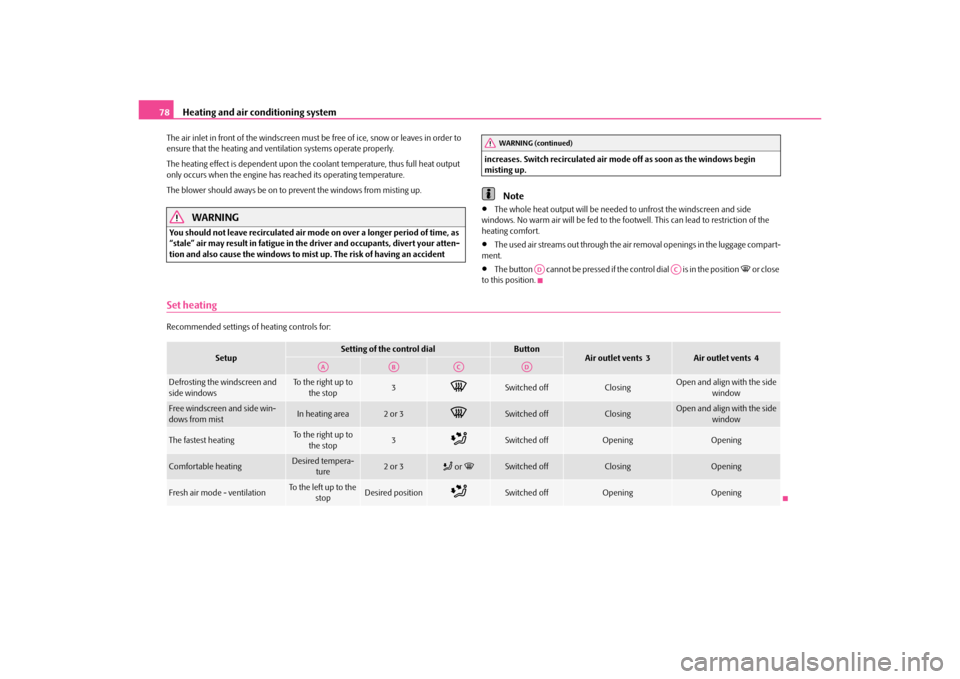
Heating and air conditioning system
78
The air inlet in front of the windscreen must be free of ice, snow or leaves in order to
ensure that the heating and ventilation systems operate properly.
The heating effect is dependent upon the c oolant temperature, thus full heat output
only occurs when the engine has reached its operating temperature.
The blower should aways be on to prevent the windows from misting up.
WARNING
You should not leave recirculated air mode on over a longer period of time, as
“stale” air may result in fatigue in the driver and occupants, divert your atten-
tion and also cause the windows to mist up. The risk of having an accident increases. Switch recirculated air mo
de off as soon as the windows begin
misting up.
Note
The whole heat output will be needed to unfrost the windscreen and side
windows. No warm air will be fed to the footwell. This can lead to restriction of the
heating comfort.
The used air streams out through the air removal openings in the luggage compart-
ment.
The button cannot be pressed if the control dial is in the position
or close
to this position.
Set heatingRecommended settings of heating controls for:
WARNING (continued)
AD
AC
Setup
Setting of the control dial
Button
Air outlet vents 3
Air outlet vents 4
Defrosting the windscreen and
side windows
To the right up to
the stop
3
Switched off
Closing
Open and align with the side window
Free windscreen and side win-
dows from mist
In heating area
2 or 3
Switched off
Closing
Open and align with the side
window
The fastest heating
To the right up to the stop
3
Switched off
Opening
Opening
Comfortable heating
Desired tempera- ture
2 or 3
or
Switched off
Closing
Opening
Fresh air mode - ventilation
To the left up to the
stop
Desired position
Switched off
Opening
Opening
AA
AB
AC
AD
s2rc.book Page 78 Thursd ay, April 22, 2010 10:58 AM
Page 81 of 207
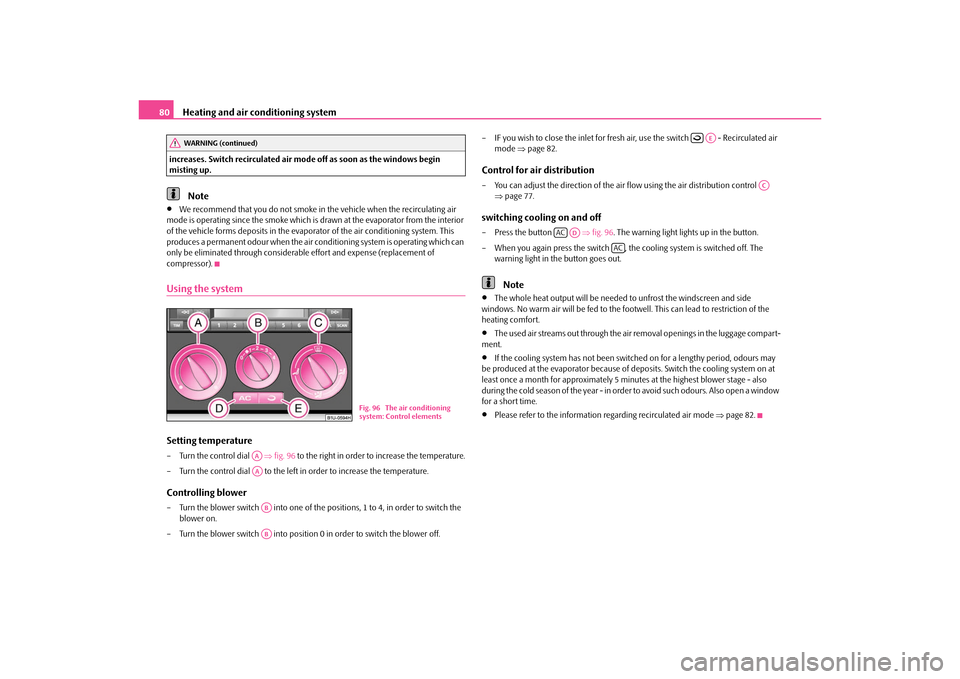
Heating and air conditioning system
80
increases. Switch recirculated air mode off as soon as the windows begin
misting up.
Note
We recommend that you do not smoke in the vehicle when the recirculating air
mode is operating since the smoke which is drawn at the evaporator from the interior
of the vehicle forms deposits in the evapor ator of the air conditioning system. This
produces a permanent odour when the air conditioning system is operating which can
only be eliminated through considerable effort and expense (replacement of
compressor).
Using the systemSetting temperature– Turn the control dial fig. 96 to the right in order to increase the temperature.
– Turn the control dial to the left in order to increase the temperature.Controlling blower– Turn the blower switch into one of the po sitions, 1 to 4, in order to switch the
blower on.
– Turn the blower switch into position 0 in order to switch the blower off. – IF you wish to close the inlet for fresh air, use the switch - Recirculated air
mode page 82.
Control for air distribution– You can adjust the direction of the air flow using the air distribution control
page 77.switching cooling on and off– Press the button fig. 96 . The warning light lights up in the button.
– When you again press the switch , the cooling system is switched off. The warning light in the button goes out.
Note
The whole heat output will be needed to unfrost the windscreen and side
windows. No warm air will be fed to the footwell. This can lead to restriction of the
heating comfort.
The used air streams out through the air removal openings in the luggage compart-
ment.
If the cooling system has not been switched on for a lengthy period, odours may
be produced at the evaporator because of deposits. Switch the cooling system on at
least once a month for approximately 5 minutes at the highest blower stage - also
during the cold season of the year - in order to avoid such odours. Also open a window
for a short time.
Please refer to the information regarding recirculated air mode page 82.
WARNING (continued)
Fig. 96 The air conditioning
system: Control elements
AAAAABAB
AE
AC
AC
AD
AC
s2rc.book Page 80 Thursd ay, April 22, 2010 10:58 AM
Page 82 of 207
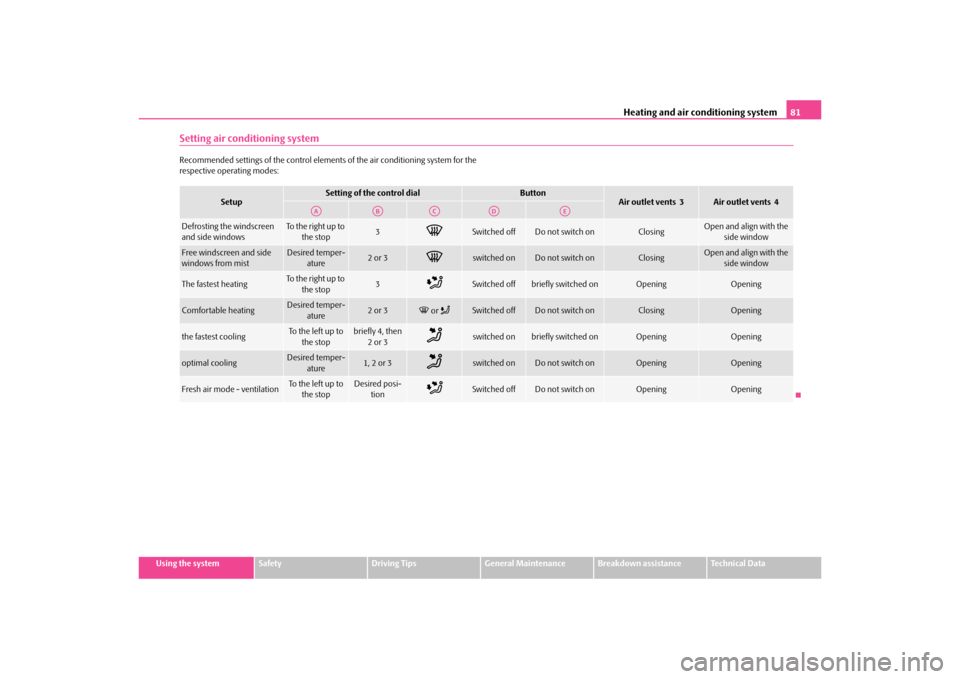
Heating and air conditioning system81
Using the system
Safety
Driving Tips
General Maintenance
Breakdown assistance
Technical Data
Setting air conditioning systemRecommended settings of the control elements of the air conditioning system for the
respective operating modes:
Setup
Setting of the control dial
Button
Air outlet vents 3
Air outlet vents 4
Defrosting the windscreen
and side windows
To the right up to
the stop
3
Switched off
Do not switch on
Closing
Open and align with the side window
Free windscreen and side
windows from mist
Desired temper- ature
2 or 3
switched on
Do not switch on
Closing
Open and align with the side window
The fastest heating
To the right up to
the stop
3
Switched off
briefly switched on
Opening
Opening
Comfortable heating
Desired temper- ature
2 or 3
or
Switched off
Do not switch on
Closing
Opening
the fastest cooling
To the left up to the stop
briefly 4, then 2or 3
switched on
briefly switched on
Opening
Opening
optimal cooling
Desired temper-
ature
1, 2 or 3
switched on
Do not switch on
Opening
Opening
Fresh air mode - ventilation
To the left up to the stop
Desired posi- tion
Switched off
Do not switch on
Opening
Opening
AA
AB
AC
AD
AE
s2rc.book Page 81 Thursd ay, April 22, 2010 10:58 AM
Page 83 of 207
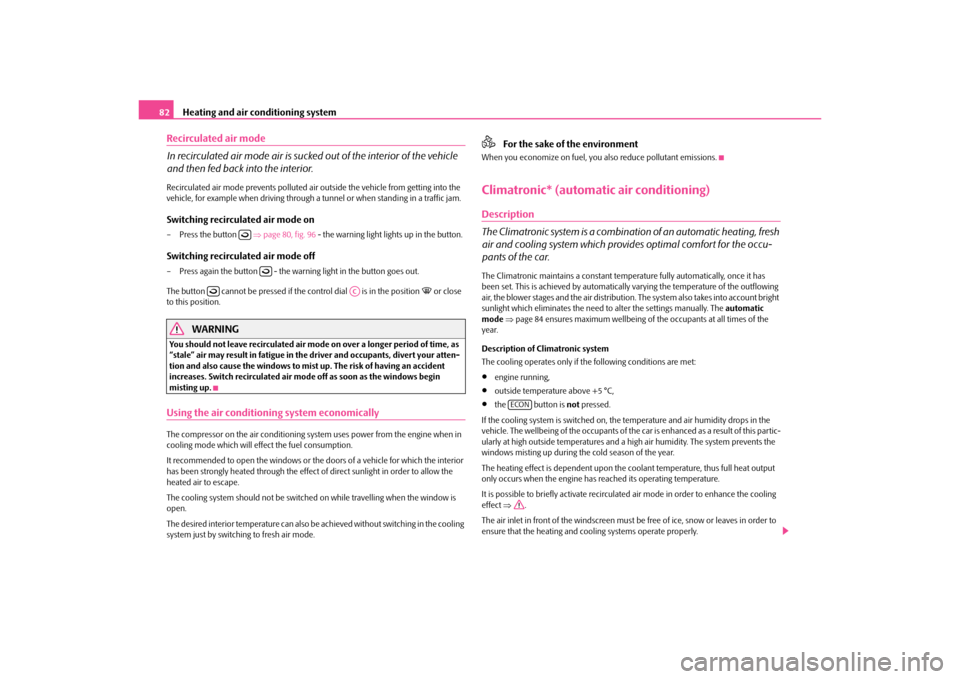
Heating and air conditioning system
82
Recirculated air mode
In recirculated air mode air is sucked out of the interior of the vehicle
and then fed back into the interior.Recirculated air mode prevents polluted air outside the vehicle from getting into the
vehicle, for example when driving through a tunnel or when standi ng in a traffic jam.Switching recirculated air mode on– Press the button page 80, fig. 96 - the warning light lights up in the button.Switching recirculated air mode off– Press again the button - the warning light in the button goes out.
The button cannot be pressed if the control dial is in the position
or close
to this position.
WARNING
You should not leave recirculated air mode on over a longer period of time, as
“stale” air may result in fatigue in the driver and occupants, divert your atten-
tion and also cause the windows to mist up. The risk of having an accident
increases. Switch recirculated air mode off as soon as the windows begin
misting up.Using the air conditioning system economicallyThe compressor on the air conditioning syst em uses power from the engine when in
cooling mode which will effect the fuel consumption.
It recommended to open the windows or the doors of a vehicle for which the interior
has been strongly heated through the effect of direct sunlight in order to allow the
heated air to escape.
The cooling system should not be switched on while travelling when the window is
open.
The desired interior temperature can also be achieved without switching in the cooling
system just by switching to fresh air mode.
For the sake of the environment
When you economize on fuel, you also reduce pollutant emissions.Climatronic* (automatic air conditioning)Description
The Climatronic system is a combinat ion of an automatic heating, fresh
air and cooling system which provides optimal comfort for the occu-
pants of the car.The Climatronic maintains a constant temp erature fully automatically, once it has
been set. This is achieved by automatically varying the temperature of the outflowing
air, the blower stages and the air distribution. The system also takes into account bright
sunlight which eliminates the need to alter the settings manually. The automatic
mode page 84 ensures maximum wellbeing of the occupants at all times of the
year.
Description of Climatronic system
The cooling operates only if the following conditions are met:
engine running,
outside temperature above +5 °C,
the button is not pressed.
If the cooling system is switched on, th e temperature and air humidity drops in the
vehicle. The wellbeing of the occupants of the car is enhanced as a result of this partic-
ularly at high outside temperatures and a high air humidity. The system prevents the
windows misting up during the cold season of the year.
The heating effect is dependent upon the coolant temperature, thus full heat output
only occurs when the engine has reached its operating temperature.
It is possible to briefly activate recirculat ed air mode in order to enhance the cooling
effect .
The air inlet in front of the windscreen must be free of ice, snow or leaves in order to
ensure that the heating and cooling systems operate properly.
AC
ECON
s2rc.book Page 82 Thursd ay, April 22, 2010 10:58 AM
Page 84 of 207

Heating and air conditioning system83
Using the system
Safety
Driving Tips
General Maintenance
Breakdown assistance
Technical Data
The AC compressor is switched off at a hi
gh coolant temperature in order to provide
cooling at a high load of the engine.
After switching on the cooling Condensation from the evaporator of the air condi-
tioning may drip down and form a puddle be low the vehicle. This is quite normal and
not an indication of a leak!
If you make a change before switching off the ignition, which differs from the auto-
matic mode, the changed functi ons remain stored. Only the function “circulating air”
is erased 20 minutes after switching off the ignition.
Recommended setting for all periods of the year:
Set the temperature to 22 °C (72 °F).
Press the button page 83, fig. 97.
Move the air outlet vents 3 and 4, so that the air flow is directed slightly upwards
page 77, fig. 94 .
Switching over between degrees Celsius and degrees Fahrenheit
Press and hold the buttons 17 and 9 page 83, fig. 97 . The information
in the desired temperature measuring unit appears in the display.
WARNING
For your own safety and that of other road users, ensure that all the
windows are free of ice, snow and mistin g. Please familiarize yourself about
how to correctly operate th e heating and ventilation systems, how to demist
and defrost the windows, as well as with the cooling mode.
You should not leave recirculated air mode on over a longer period of time,
as “stale” air may result in fatigue in the driver and occupants, divert your
attention and also cause the windows to mist up. The risk of having an accident
increases. Switch recirculated air mode off as soon as the windows begin
misting up.Note
If the cooling system has not been switched on for a lengthy period, odours may
be produced at the evaporator because of deposits. Switch the cooling system on at
least once a month for approximately 5 minut es at the highest blower stage - also during the cold season of the year - in order to avoid such odours. Also open a window
for a short time.
We recommend that you do not smoke in
the vehicle when the recirculating air
mode is operating since the smoke which is drawn at the evaporator from the interior
of the vehicle forms deposits in the evapor ator of the air conditioning system. This
produces a permanent odour when the air conditioning system is operating which can
only be eliminated through considerable effort and expense (replacement of
compressor).
The used air streams out through the air removal openings in the luggage compart-
ment.
Using the cooling economically page 82.
Overview of the control elements
The controls enable a separate setting of the temperature for the left
and right side.Fig. 97 Climatronic: Control elementsThe buttons
Defrosting the windscreen
Display Display of blower stages
When switching off the automatic air cond itioning with the button 11, the outside
temperature now indicates OFF, ot her information is not indicated.
AUTO
ECON
AUTO
A1
A2A3
s2rc.book Page 83 Thursday, April 22, 2010 10:58 AM